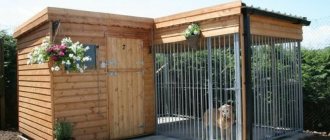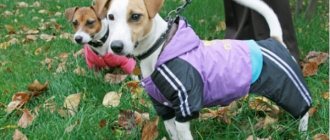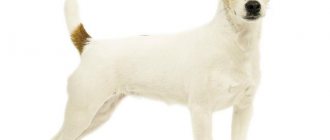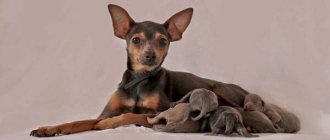The Jack Russell Terrier is originally a hunting dog breed.
She is distinguished by her instant response, activity and friendliness.
Nowadays, this dog has become an excellent companion for people who do not sit still and lead an active lifestyle.
In this article we will talk about Jack Russell puppies - how to choose them and how to care for them. We will also show you photos of these cute babies.
History of the Jack Russell Terrier breed
Smooth-haired Jack Russell Terrier
There are breeds that have lived side by side with humans for so long that it is only possible to reliably learn about their roots with the help of geneticists. This is, for example, the situation with the ancestors of Jack Russells - fox terriers. Their first descriptions are found in Roman chronicles from the time of Caesar’s campaigns against Albion.
But the closer we get to modern times, the more documentary evidence there is, so today no one doubts that the Jack Russell Terrier owes its appearance to a very specific enthusiast - John “Jack” Russell. Following family tradition, he became a priest and headed a small parish in the south of Britain, but this man’s true passion remained not serving the church, but parfors hunting and breeding dogs for it.
Even in John's last year of study at Exeter College, Oxford University, a significant meeting took place. During one of his walks, he saw a dog that embodied the ideal qualities of a real fox hunter: compact size, passion, vigilance and fearlessness. The treasure belonged to a local milkman, who was unlikely to be able to fully appreciate the mentioned advantages, so the first owner immediately gave Trump up to a persistent student. With this Trump - this is how the English word Trump is translated - many years of selection work began.
Of course, outwardly, the ancestor of the breed does not look so much like the current “Jacks”. The similarity is noticeable only in color: against the dominant white background, darker spots stood out in the area of the eyes, ears and at the base of the hook-shaped tail. Judging by the surviving drawings, Trump was a poor-boned dog with a small skull. Most likely, her family included the now extinct English White Terriers.
It must be said that in the process of breeding a new breed, the pastor used representatives of various burrow dogs. There is no exact data about experiments with the gene pool, since the breeder did not keep any journals with records, or they simply did not survive. Researchers believe that fox terriers of the old format, border dogs, lakelands, Irish terriers, and Scottish cairns left their mark on the formation of the breed. Russell set himself the task of improving the working qualities of the offspring, and he did not consider it necessary to cull puppies because of the shape of the skull or the position of the tail. As a result, the unsightly and roughly cut short-legged pets of the Devonshire priest won the ardent love of all the surrounding hunters.
Although the vicar himself was involved in boxing (which in the 19th century was a very tough sport, because protective gloves were not used), he was not prone to cruelty and publicly condemned those fellow breeders who mixed the blood of fighting dogs into terriers. For John, fox hunting was incompatible with killing or severely injuring prey; he considered the main goal to be a competition between foxes and his animals in speed and endurance. Russell's terriers did not require the ferocity and powerful jaws of a bulldog.
Wirehaired Jack Russell Terrier puppy
The pastor's achievements in breeding and popularizing terriers did not go unnoticed. In 1873, he, along with Sewallis Shirley and a dozen like-minded people, took part in the creation of the organization that is today known as the oldest kennel club - the English Kennel Club. In subsequent years, John Russell was invited as a judge to exhibitions, but did not exhibit his own pets, calling them wild rose hips against a background of greenhouse roses. And this comparison was not in favor of the latter.
John Russell, who devoted much of his life to dog breeding, died at the age of 87 and was buried in the village of Swimbridge - in the cemetery next to the medieval church of St. James, where he served. Since he actively sold puppies and adult dogs, at the time of his death the breeder had only 4 dogs.
The development of the breed was continued by a young colleague, Arthur Heinemann. He is the author of the first draft of the breed standard. In 1914, the Parson Jack Russell Terrier Club (parson means “priest”) was founded and existed until the 40s. In the middle of the century, Russell's terriers began to be crossed with dachshunds and Welsh corgis to improve their character and working qualities. As a result, not only “classic” animals, but also short-legged animals began to appear. The latter were considered undesirable for a long time and in the eyes of the jury invariably lost to their tall brothers.
It is unknown what the fate of the “side branch” would have been if, in the 1960s, several dogs with short legs had not ended up on the Green Continent. The Australians, of course, did not intend to hunt with them, but they appreciated the energy and intelligence of their new pets, so they took up the development of the breed with great enthusiasm.
Official recognition by the Kennel Club and the FCI came only in 1990. Then both types of dogs were included in the standard of the International Canine Organization under the general name Parson-Jack Russell Terrier. However, activists from the UK and Australia did not give up attempts to achieve differentiation, and in 2001 two standards were adopted: for the Parson Russell Terrier (animals with long legs with a square body) and the Jack Russell Terrier (short legs with an elongated body).
Hunting qualities
Like many other members of the terrier group, Jack Russell Terriers were bred to hunt small, burrow-dwelling game. Of course, terriers do not have enough speed and power for tracking and pursuit, but English foxhounds or other hounds did an excellent job with this task, but in penetrating an underground shelter and in a fight forcing the “fugitive” to leave it, the persistent and compact hounds have no equal strong guys.
Jack Russell exploring the hole
It was already mentioned above that Jack Russell Terriers gained their reputation as excellent burrow dogs not for their ferocity, but for their clear voice and high intelligence. They not only understood the hunters’ strategy in a given situation, focusing on various horn signals, but also made their own decisions, which helped save energy without sacrificing efficiency.
Since their introduction, "jacks" have been an integral part of rural life in Great Britain. However, since 2002 in Scotland, and since 2005 in England and Wales, fox hunting has been officially banned, although for many it was part of the country's cultural heritage. Badgers are also now protected by conservation organizations. In southern Spain there is still a hunting area where it is possible to pursue game on horseback, but in most European countries the tradition is fading into history due to the lack of uninhabited areas with suitable landscape.
But innate instincts cannot be canceled as easily as centuries-old rituals, so four-legged “city dwellers” do not miss the opportunity during a walk to chase a passing cat or dig an impressive hole in the roots of trees from the nearest park.
Upbringing
There are 3 types of training: burrow hunting, searching for wounded animals, game hunting, including pursuit on the ground. Owners themselves decide which is preferable for their plans. Training begins at 8-10 weeks of age and takes place in a playful way. With age, classes become more difficult.
- They build obstacles and use incentives. The animal is characterized by temperament and unconditional obedience must be curbed.
Self-confidence, pressure, activity are manifested from a young age. If you let your pet's life take its course, it will educate itself.
The result will be damage to furniture, shoes, carpets, books, and cords. Holes will form in the sofas, and the Internet, TV and washing machine will stop working. Become the leader of the pack, the dog will obey the leader.
Appearance of Jack Russell Terriers
The Jack Russell Terrier is a small but powerfully built dog. Height at the withers is 25-30 cm. There are no strict weight standards, however, experts note that the Jack Russell Terrier looks harmonious, having 1 kg of weight for every 5 cm of height, that is, the desired weight of an adult representative of this breed is 5-6 kg.
Body
Who is there?
The silhouette of the Jack Russell Terrier is strictly rectangular, elongated (the length from the withers to the base of the tail is greater than the height at the withers).
Head
The skull is flat and moderately wide. The muzzle is somewhat shorter than the skull. The transition from forehead to muzzle is well defined, but not too pronounced.
Nose
Careful. The lobe is black. The nostrils are developed and well open.
Eyes
Almond-shaped, dark. Not bulging, the eyelids lie close to the eyeball and are darkened along the edges.
Teeth and jaws
The Jack Russell Terrier's jaws should be strong, powerful, and have strong teeth. Scissor bite. The lips are black and tightly closed.
Jack Russell Terrier admiring the sunset
Ears
"Buttons" or hanging. Small, folded in front. Extremely flexible, can rotate 180°. The tips are V-shaped.
Neck
Strong, with a clean, crisp line.
Frame
The croup is even. The loin is short, strong and muscular. The back is strong and fairly narrow.
Breast
Deep, not wide. The ribs are strongly prominent at the base and noticeably flattened at the sides. The circumference of the ribs behind the elbows is 40-43 cm.
Tail
At rest, the Jack Russell Terrier's tail may be lowered, but when moving, it always rises.
Forelegs
They look the same both from the front and from the side. Straight, well set under the body. The shoulder blades have a good slope back and are not overloaded with muscles.
Hind limbs
Strong and muscular. The knee joints are strongly bent, the hocks are low. The metatarsals are parallel when viewed from behind.
Paws
Small, round in shape, with hard pads. Placed straight. The fingers are medium rounded.
Wool
Jack Russell Terriers have three types of coat: hard, smooth or kinky. Should provide good weather protection.
Color
Predominant white background with dark spots. The color of the spots can vary from black and dark chestnut to red.
What do newborn puppies look like?
Puppies are born blind, their muzzle and body do not yet have the proportions of an adult dog, so it is not yet possible to judge their future appearance. This can be done much later.
The puppy's coat already has a color that will remain in the future. The tail is pressed to the body, the ears puff up. The tip of the nose and paws are pink or pinkish in color. The type of coat is not yet clear.
Jack Russell puppies are 14-16 cm in size at birth. Weight usually exceeds 200 g and ranges from 200 to 250 g.
These indicators are not universal, they depend on:
- heredity;
- the period at which the puppies were born;
- number of puppies in the litter.
Photo of an adult Jack Russell Terrier
Character of the Jack Russell Terrier
Shall we play?
The Jack Russell Terrier is a real perpetual motion machine. He is simply physically unable to sit in one place for a long time and get bored while waiting for the game. This dog will attract the owner's attention in every possible way. She knows perfectly well the rules of behavior in the house and can deliberately break them in order to provoke at least some reaction from the owner, who is too carried away by his favorite TV series or a new book.
It is important to remember about the high intelligence of your pet. Physical activity must be accompanied by mental activity, otherwise any activity will quickly become boring. Alternate teams and toys, come up with new types of activities.
In general, representatives of the breed are distinguished by their cheerful and friendly disposition. Jack Russell Terriers are great for families where the children are old enough not to treat the pet like a teddy bear. Only dogs whose upbringing has made serious mistakes since early childhood can show aggression for no reason.
Representatives of this breed do not get along well with other animals in the house due to the hunter genes. Neighborhood with rodents is especially undesirable, because Jack Russells are famous rat catchers, but they can also cause trouble for cats. In relations with dogs of their own or another breed (regardless of the size of the enemy), due to their brave and capricious nature, they will always try to dominate, constantly getting into skirmishes.
Education and training
Jack Russell Terriers are best suited to experienced owners as they are naturally cunning, independent and have a desire for leadership. If you feel that you cannot fully cope with the character of the new family member, seek advice and help from a canine specialist as soon as possible.
Early socialization of a puppy is important so that in the future he can coexist peacefully with household members (including children and the elderly), other pets, and does not show aggression towards guests and random passers-by during walks.
The main behavioral problems in Jack Russell Terriers include stubbornness, loud barking, damage to household property, anxiety from loneliness, digging and chasing small animals. All of them can be corrected with due attention from the owner. A dog shows the worst sides of its character only if it does not meet with opposition or sees this as the only way to attract the attention of its owner.
The breed lends itself well to training, the main thing is to be patient during the process, not to forget about the reward and not to raise your voice. Establishing the authority of the owner is extremely important, but it can and should be achieved through calm firmness. Your pet should respect and listen to you, and not be afraid.
First vaccinations
At 21 days, the puppy and mother are dewormed. This is usually done with a suspension of Drontal Junior, Pirantel and other drugs.
At 4-6 weeks they are vaccinated against distemper and parvovirus enteritis.
At 3-9 weeks the following vaccinations are given:
- repeatedly from plague and parvovirus enteritis;
- from hepatitis;
- from parainfluenza;
- from leptospirosis.
At 12 weeks, revaccination against distemper, hepatitis, parvovirus enteritis, and leptospirosis is carried out. Vaccination against rabies is carried out.
At 6-8 months after changing teeth, revaccination against distemper, hepatitis, parvovirus enteritis and leptospirosis is carried out.
Care and maintenance
Despite the compact size of Jack Russells, keeping them in a city apartment is fraught with certain difficulties. Dogs are too active for quarter-hour walks in the morning and evening to satisfy their need for exercise. With a lack of training, they will spend excess energy on destructive pranks. As a result, furniture, appliances, floors, shoes and clothes of the owners may be damaged. It should be understood that for the Jack Russell Terrier this is not an act of revenge or deliberate sabotage, but simply an attempt to occupy itself with something in the absence of the owner, so before leaving for several hours you need to find time for a long and meaningful walk.
From a young age, your pet should know that he has his own territory in the house. Choose a location that is protected from drafts and not too close to heat sources. It is necessary to purchase a natural mattress that is strong enough to withstand the attacks of powerful teeth. You should keep toys nearby that your Jack Russell Terrier can chew with impunity after waking up.
Grooming will not cause excessive trouble, although this breed, if kept completely indoors, sheds throughout the year. Only wire-haired terriers need trimming with special tools; the rest need regular brushing. Frequent bathing is contraindicated because it damages the natural protective layer on the pet's fur and skin. After walks, just wipe your paws with a damp towel or animal wipes.
Teeth should be brushed once or twice a week using a specialized toothpaste. Inspect and clean your ears twice a month.
The Jack Russell Terrier has standard nutritional requirements. Either premium and super-premium food, or balanced natural food. In the latter case, the ratio of meat (beef, veal, cooked poultry and offal) and plant components should be 2:1.
Development by months
At one month the puppy already has its first teeth:
- fangs;
- incisors;
- the first and second false-root ones.
He begins to emerge from his den along with the other puppies.
This is the time when you need to start toilet training your dog. During the first month, the breeder observes an increase in the puppy’s activity and how he gets used to his name. The dog develops a daily rhythm.
IMPORTANT!
At the age of 45 days it is recommended to brand the puppy. At this time, the baby is also already accustomed to hygiene procedures - combing, cleaning the ears and examining the teeth.
The puppy continues to explore the world. Closer to the age of two months, he begins to better remember commands, chew and ruffle objects around him. He is growing and gaining weight, but at this age it is still impossible to see the puppy’s shortcomings.
Further development occurs in the following order:
- At 2-2.5 months, the puppy begins a period of fear. At this time, you need to communicate with him as much as possible and avoid things that would frighten the dog. Also at this time the puppy is already switching to food. At 2 months, the puppy begins to bark and all of his baby teeth appear. This is the right time to start accustoming him to trips and walks. The dog continues to grow and gain weight;
- from 2 to 5 months, the proportions of the dog’s head and body are determined. Character and teeth change;
- at 3 months the dog is already ready for independent life. During these three months, his individual character traits are formed;
- from 4-8 months the dog begins to want to run away from its owner. This is the time for the dog's "sexy" games. The optimal age to move to a new family. The puppy is fully formed and after changing teeth the bite is visible. At this age, the dog’s character, its preferences and habits are visible;
- at 7-8 months the dog’s growth stops;
- at 8-9 months the dog’s teeth finally change. Fangs that have not fallen out need to be pulled out;
- from 6-10 months the bitch begins her first heat and puberty begins. Males mark their territory and raise their paw;
- 6-12 months is a time of fear of new situations. A new trusting relationship is formed between the dog and the owner. During this period, you should not force the dog to approach the object that it is afraid of;
- at 12 months, the dog completes the formation of the “dominance-submission” relationship.
Health and disease of the Jack Russell Terrier
Playing Frisbee with a Jack Russell
In general, Jack Russell Terriers can be called hardy dogs with good health. But they are not immune from a number of congenital and acquired diseases:
- osteochondropathy of the femoral head (Perthes disease) manifests itself in puppies 4–10 months old in the form of constant or periodic lameness;
- dislocation of the kneecap;
- hip dysplasia, although large breeds are more often considered at risk, does not bypass terriers;
- deafness;
- heart diseases;
- epilepsy;
- hereditary defects in the development of the sclera, choroid, retina, optic nerve and retinal vessels - the so-called collie eye anomaly.
To ensure your pet's well-being and improve his quality of life well into his old age, visit your veterinarian regularly for preventive examinations and follow his recommendations. Do not self-medicate if symptoms of various diseases occur.
What should the diet be like?
In the first few weeks that you have a puppy, you should feed it the same as the breeder fed it, gradually transitioning it to the desired diet .
If you plan to feed your Jack Russell with industrial food in the future, then choose premium or super-premium products.
If you want to feed your pet natural food, then begin to gradually introduce the following products into his diet:
- meat;
- fish;
- dairy products;
- cereals;
- vegetables and fruits;
- eggs.
For 1 kg of puppy, 20-30 g of meat per day is required.
Ideal meat choices include beef, turkey and chicken breast. Shred the beef before serving, but you will have to cook the chicken and turkey.
A couple of times a week you should give fish, but only sea or ocean fish. Before serving, boil and remove bones.
At first, small puppies should replace cow's milk with 10% cream diluted with water. Calcined cottage cheese can also be an alternative. It should be given several times a week, 30-50 g.
You can start your first complementary foods with buckwheat and rice porridges.
The Jack Russell digests carrots, beets, zucchini and pumpkin best. During the season, you can add a little greenery to them.
You can give an apple as a fruit. You can give other fruits if the puppy is interested, but you should avoid feeding citrus fruits .
Sometimes give your puppy an egg omelet, but no more than 1-2 times a week.
How to choose a puppy
The appearance of Jack Russell Terriers on the silver screen and in photo reports from glossy magazines about the lives of celebrities did not have the best effect on the breed. There are many unscrupulous breeders who strive to make a profit from selling popular animals and do not care at all about the gene pool and raising children.
It is very important to buy puppies only from breeders with an impeccable reputation and in the best kennels. Of course, such Jack Russells will cost more, but in the future you will not have to deal with uncontrollable dog behavior or spend all your free time in clinics due to hereditary health problems.
When meeting a Jack Russell Terrier for the first time, it is important to pay attention to the behavior of the chosen puppy. He should be playful, energetic and sociable. Lethargy, apathy and lack of appetite indicate poor health, and aggression or fear of the outside world indicate mental instability. Do not ignore the living conditions of mother and babies. Cleanliness, sufficient space and the presence of toys indicate a responsible attitude of the breeder no less than the presence of official documents and routine vaccinations.
What price?
Many breeders specialize in breeding certain types of dogs. This requires a wealth of knowledge and special care to maintain the quality of the breed. Even a buyer should know all the physical characteristics of a puppy before deciding to buy it. As a rule, animals from a reputable breeder are registered with a reputable kennel club. In addition, he spends a huge amount of money to provide them. So, the starting price of a puppy with documents from a reputable breeder is 35,000-45,000 rubles. If you decide to purchase a puppy from titled parents, be prepared to pay 80,000 rubles . And if there are not so many championship titles or not at all, then the price is reduced by two or three times.
Puppies without a pedigree can be purchased from 10,000 to 15,000 rubles . If the cost is less than 10,000, then most likely they are offering you a sick dog. Grown-up specimens cost about 25,000, but be prepared to invest in a professional trainer.











